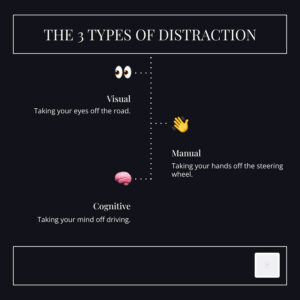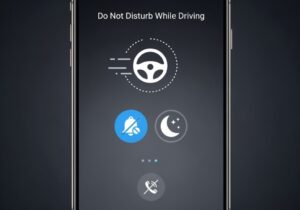
The Sobering Reality: A Look at the Latest Statistics
Our roads are busier than ever, yet a silent epidemic continues to endanger us all. It’s not just speeding or impaired driving that poses a major threat; it’s also the pervasive issue of distracted driving. This behavior, often seemingly harmless, has become a leading cause of preventable accidents and fatalities across North America.
We often underestimate the profound impact a momentary lapse in attention can have behind the wheel. The consequences are far-reaching, changing lives in an instant. This growing concern demands our immediate attention and understanding.
We will unpack the sobering reality of distracted driving. We will delve into the latest statistics, examine the devastating human cost, and explore the key behaviors that contribute to this crisis. We will also discuss the significant economic impact, the challenges in data collection, and the efforts being made to combat this preventable threat. Our goal is to shed light on why the numbers of annual distracted driving deaths continue to be a critical public safety concern. Join us as we explore the facts and consider how we can all contribute to safer roads.
The statistics on distracted driving are a stark reminder of its pervasive danger. According to the National Highway Traffic Safety Administration (NHTSA), distracted driving claimed 3,308 lives in 2022. While preliminary estimates for 2023 show a slight decrease to 3,275 fatalities, the numbers remain tragically high. Beyond the fatalities, an estimated 289,310 people were injured in crashes involving distracted drivers in 2022 alone. This means that 8% of all fatal crashes in 2022 were attributed to distraction. The human toll is immense, affecting countless families and communities.
To put these figures into perspective, it’s important to consider how distracted driving compares to other risky behaviors on our roads. In some regions, the danger posed by distracted driving has even begun to eclipse that of impaired driving. This shift highlights a critical, evolving challenge in road safety.

The Scope of the Problem in North America
The issue of distracted driving is not confined to one nation; it is a significant concern across North America. In the United States, the NHTSA consistently tracks and reports these grim figures, underscoring the ongoing battle against inattentive driving. Their detailed reports, such as the Traffic Safety Facts Research Note: Distracted Driving 2022 and Research Note: Distracted Driving in 2023, provide invaluable insights into the scale of the problem.
Across the border, Canada faces a similar struggle. Data from organizations like the Canadian Automobile Association (CAA) and the Traffic Injury Research Foundation (TIRF) reveal a troubling trend. For instance, the Government of Canada reports that distracted driving has become a leading cause of collisions, injuries, and fatalities. In fact, some Canadian sources, including the ICBC, indicate that deaths caused by distracted driving have, in certain areas, surpassed those caused by impaired driving. This is a profound and alarming development, suggesting that public perception and enforcement strategies may need to adapt to this new reality.
Provincial data in Canada further emphasizes the localized impact. For example, in British Columbia, the ICBC states that 77 people are killed each year due to crashes involving distracted driving, contributing to over 6,500 injuries annually. Similarly, in Ontario, distracted driving has been cited as the leading cause of accidents, accounting for a significant percentage of all crashes. These regional variations highlight the necessity for tailored public awareness campaigns and targeted enforcement efforts to address the distinct challenges faced by various communities.
The Human Cost: A Deeper Dive into Annual Deaths from Distracted Driving
While the overall fatality numbers are staggering, a closer look reveals the disproportionate impact of distracted driving on vulnerable road users. These include pedestrians, cyclists, and other non-occupants who share our roadways. In 2022, NHTSA reported that 621 pedestrians, cyclists, and other non-occupants were killed in crashes involving distracted drivers. This highlights that the danger extends far beyond vehicle occupants, affecting anyone in the path of an inattentive driver.

Demographics of Distracted Drivers and Victims
Distracted driving does not discriminate, but certain demographic groups are unfortunately overrepresented in the statistics, both as drivers causing crashes and as victims.
High-Risk Age Groups: Data consistently shows that younger drivers, particularly those aged 15-20, have the largest proportion of drivers who were distracted at the time of fatal crashes. For instance, a Miller and Zois article on texting and driving statistics notes that 39% of high school students surveyed admitted to texting or emailing while driving. This age group is still developing critical driving skills and judgment, making them particularly susceptible to the allure of digital distractions.
However, the problem isn’t exclusive to young drivers. NHTSA reports indicate that drivers aged 25-34 also show a higher proportion of distracted drivers in fatal crashes. Surprisingly, elderly drivers (75 and older) also appear to have a larger proportion of distracted drivers in fatal crashes, possibly due to slower reaction times or unfamiliarity with new in-vehicle technologies.
Gender Differences: While both men and women engage in distracted driving, some studies suggest slight gender differences in behavior. For example, a Hello Safe article on Canadian statistics indicates that men are more likely than women to use mobile phones while driving. However, the critical takeaway is that distracted driving is a widespread issue affecting all demographics, and its devastating impact on annual distracted driving deaths necessitates a collective effort to promote safer habits.
What’s Driving the Distraction? Key Behaviors and Contributing Factors
Distracted driving is defined as any activity that diverts a driver’s attention from the primary task of operating a vehicle safely. While mobile phones often come to mind, the spectrum of distractions is much broader.
Common Distractions Include:
- Cellphone Use: This is arguably the most prevalent and dangerous form of distraction. It encompasses texting, talking on a handheld phone, checking social media, browsing the internet, or using navigation apps. The National Safety Council (NSC) estimates that approximately 1.6 million crashes occur annually due to drivers using cell phones and texting.
- Eating and Drinking: Reaching for food or beverages, unwrapping items, or even taking a bite can take eyes, hands, and cognitive focus away from the road.
- Talking to Passengers: Engaging in deep conversations, managing children, or dealing with pets can divert attention, especially in complex traffic situations.
- Adjusting Vehicle Controls: Fiddling with the radio, climate control, GPS, or other infotainment systems requires visual and manual attention.
- Reaching for Objects: Dropping something on the floor, searching for an item in the glove compartment, or reaching into the back seat can lead to dangerous moments of inattention.
- Grooming: Applying makeup, combing hair, or shaving while driving are clear examples of manual and visual distractions.
- Outside Events: Rubbernecking at an accident, looking at billboards, or observing activity outside the vehicle can also be distracting.
These behaviors fall into three main categories of distraction:
- Visual: Taking your eyes off the road.
- Manual: Taking your hands off the steering wheel.
- Cognitive: Taking your mind off driving.
Many common distractions, especially cellphone use, involve all three types simultaneously, significantly elevating the risk.

Quantifying the Risk of Common Distractions
The impact of distracted driving on crash risk is alarming. Consider the widely cited “football field analogy”: NHTSA states that answering a text takes your eyes off the road for about five seconds. Traveling at 55 mph, that’s enough time to travel the length of an entire football field with your eyes closed. This vivid comparison highlights how quickly a driver can cover significant ground without being aware of their surroundings.
The increased risk associated with distraction is quantifiable. Drivers who engage in distracted behaviors are significantly more likely to be involved in a crash or near-crash event. Some studies, such as those cited by Think Insure, suggest that drivers are up to four times more likely to be involved in an accident when talking on a phone while driving. For texting, the risk escalates dramatically, with some research indicating that texting while driving increases the risk of an accident by as much as 23 times. The National Safety Council (NSC) also reports that drivers who drive distracted are 8 times more likely to be in a crash or near-crash event compared to non-distracted drivers. These figures highlight the severe consequences of even brief moments of inattention.

The Ripple Effect: Economic Impact and Data Collection Challenges
The consequences of distracted driving extend far beyond the immediate human tragedy of fatalities and injuries. There is a substantial economic and societal burden that impacts individuals, healthcare systems, insurance companies, and the economy as a whole.
NHTSA estimates that the economic cost of all motor vehicle traffic crashes in the U.S. in 2019 was $340 billion. Of this staggering amount, distracted driving crashes alone accounted for an estimated $98 billion in tangible losses. When considering the broader societal harm, which includes the intangible value of lost quality of life, the figure skyrockets to an estimated $395 billion. These costs encompass a wide range of factors, including:
- Lost Productivity: Due to fatalities, long-term disabilities, and time off work for recovery.
- Medical Expenses: For emergency care, hospital stays, rehabilitation, and ongoing treatment.
- Property Damage: Costs associated with vehicle repairs or replacement, as well as damage to infrastructure.
- Legal and Administrative Costs: Including police investigations, court proceedings, and insurance processing.
Data Limitations and Underreporting
Despite the extensive data collected by agencies like NHTSA and the NSC, accurately quantifying distracted driving incidents remains a significant challenge. This is primarily due to several inherent limitations in data collection:
- Underreporting: Distracted driving is notoriously difficult to prove at a crash scene. Unlike alcohol impairment, there’s no breathalyzer test for distraction. Drivers are often reluctant to admit to being distracted, especially when it involves using their phone illegally. Law enforcement officers must rely on witness statements, physical evidence, or, in some cases, driver admission, which are often insufficient or unavailable.
- Police Crash Reports (PCRs): The consistency and detail of PCRs vary significantly across different jurisdictions. Some states or provinces may have specific codes for various types of distractions, while others might rely on narrative descriptions, making it more challenging to standardize data. The rapid evolution of technology also means that PCR forms may not always keep pace with new forms of distraction (e.g., specific apps, video streaming).
- Self-Reporting Bias: Surveys that ask drivers about their distracted driving habits are subject to self-reporting bias. While many drivers acknowledge the dangers, a significant percentage admit to engaging in the behavior themselves. For example, the AAA Foundation found that roughly 93% of drivers consider handheld cell phone use dangerous, yet 27% reported sending a text/email while driving. This discrepancy between awareness and action makes it challenging to obtain a comprehensive picture through surveys alone.
- Lack of Information in Fatal Cases: In crashes involving driver fatalities, it can be particularly challenging to determine if distraction was a factor, as the primary source of information (the driver) is no longer available.
These challenges mean that the true scope and frequency of distracted driving incidents, and consequently the full count of annual deaths from distracted driving, are likely much higher than official statistics suggest. This “hidden epidemic” underscores the critical need for continued research, improved data collection methodologies, and widespread public awareness.
Combating the Crisis: Prevention, Laws, and Technology’s Role
Addressing the crisis of distracted driving requires a multi-faceted approach involving legislation, enforcement, public awareness, and technological solutions.
Laws and Enforcement Strategies: Over the past decade, there has been a significant push to enact and strengthen laws against distracted driving across North America. As of April 2023, the NSC reports that 24 states and the District of Columbia have banned the use of hand-held devices for all drivers, while 48 states and D.C. have banned texting while driving. In Canada, all provinces and territories have laws against distracted driving, though penalties vary. For detailed information on specific state laws, resources like the Governors Highway Safety Association (GHSA) can be invaluable.
These laws are often coupled with high-visibility enforcement campaigns. NHTSA’s “Put the Phone Away or Pay” campaign, for instance, pairs national advertising with increased law enforcement efforts during specific periods, like Distracted Driving Awareness Month in April. The goal is to create a strong deterrent by emphasizing that distracted driving carries serious legal and financial consequences.
Prevention Strategies and Public Awareness: Beyond legal frameworks, prevention hinges on changing driver behavior. Public awareness campaigns, often led by organizations like the CDC and NHTSA, aim to educate the public about the dangers. These campaigns usually highlight the tragic personal stories of victims and the severe penalties for violations. Initiatives like “National Do Not Disturb While Driving Day” (October 17th), promoted by the National Distracted Driving Coalition, encourage drivers to activate their phone’s built-in “Do Not Disturb While Driving” feature.

Technological Solutions: Smartphones now come equipped with features designed to combat distraction. The “Do Not Disturb While Driving” (DNDWD) setting, available on most modern smartphones, automatically silences notifications and prevents incoming calls (except from favorites) when the phone detects that the user is driving. This simple feature can be a powerful tool in reducing temptation and keeping drivers focused on the road. However, widespread adoption and consistent use of these features remain a challenge.
The Double-Edged Sword of Automotive Technology
While technology offers solutions, it also presents new challenges. Modern vehicles are increasingly equipped with advanced driver-assistance systems (ADAS) and semi-automated features, such as adaptive cruise control, lane-keeping assist, and self-parking capabilities. While these technologies are designed to improve safety, they can inadvertently contribute to driver distraction through a phenomenon known as “automation complacency.”
A study by the AAA Foundation highlighted this paradox, showing that as people grow more comfortable with the technology features in their cars, they are more likely to engage in distracted driving. Drivers may mistakenly believe that these systems allow them to divert attention from the road, leading to a false sense of security. This can result in delayed reactions when the system disengages or encounters situations it cannot handle.
The future of vehicle safety will depend not only on the advancement of technology but also on how effectively we educate drivers about its limitations and prevent complacency. Striking the right balance between technological assistance and maintaining driver engagement is crucial to truly reducing the risk of distracted driving incidents.
Frequently Asked Questions about Distracted Driving
We recognize that the topic of distracted driving is complex, with numerous nuances and evolving information. Here, we address some of the most common questions to provide clarity and actionable insights.
What are the three main types of distracted driving?
Distracted driving typically falls into three main categories, often overlapping:
- Visual Distraction: This occurs when a driver takes their eyes off the road for even a moment. Examples include looking at a phone, glancing at a billboard, or turning to talk to a passenger in the back seat.
- Manual Distraction: This happens when a driver takes their hands off the steering wheel. This could involve texting, adjusting the radio, eating, or reaching for an object.
- Cognitive Distraction: This is perhaps the most insidious, as it involves taking your mind off the task of driving, even if your eyes are on the road and your hands are on the wheel. Examples include engaging in deep thought, being emotionally upset, or even talking on a hands-free device, as studies show that the conversation itself can divert mental attention. It’s crucial to remember that “hands-free is not risk-free.”
Many activities, such as texting, involve all three types of distraction simultaneously, making them exceptionally dangerous.
What are the latest figures for annual deaths from distracted driving in the US?
According to preliminary data from the National Highway Traffic Safety Administration (NHTSA), an estimated 3,275 people were killed in motor vehicle crashes involving distracted drivers in 2023. This follows 3,308 deaths in 2022. While these numbers represent a slight decrease from previous years, they underscore the persistent danger.
These figures are likely an underestimation due to the challenges in accurately collecting data on distracted driving incidents. The true number of fatalities where distraction played a role is almost certainly higher, as it can be difficult for law enforcement to confirm distraction at the scene of a crash, especially if the driver is deceased or unwilling to admit to the behavior.
How can I prevent myself from driving distracted?
Preventing distracted driving requires a conscious commitment and proactive measures. Here are some effective strategies:
- Activate “Do Not Disturb While Driving” Mode: This is one of the simplest and most effective steps. Enable your smartphone’s DNDWD feature to automatically silence notifications and prevent incoming calls when you’re behind the wheel.
- Put Your Phone Away: Once you’re in the car, place your phone in the glove compartment, the back seat, or any place where it’s out of reach and out of sight. The temptation to check it will be significantly reduced.
- Set Up Before You Go: Before you start your journey, set your GPS, choose your music or podcast, and make any necessary phone calls. Do all this while parked safely.
- Limit Passenger Interactions: If you have passengers, especially children, try to address their needs before driving or during a safe stop. Explain to adult passengers that you need to focus on the road.
- Eat Before or After: Avoid eating or drinking anything that requires significant attention while driving. Save meals for when you’re safely parked.
- Pull Over for Complex Tasks: If you absolutely need to make a call, send a text, or deal with a complex navigation issue, pull over to a safe location before doing so.
- Be a Good Passenger: If you’re a passenger, speak up if the driver appears to be distracted. Offer to handle their phone, adjust the radio, or steer for them.
By adopting these habits, we can all contribute to making our roads safer for everyone.
Conclusion
The numbers don’t lie: distracted driving remains a pervasive and deadly threat on our roads. From the thousands of lives lost annually in both the U.S. and Canada to the hundreds of thousands injured and the staggering economic costs, the ripple effect of inattention behind the wheel is undeniable. We’ve seen how this epidemic disproportionately affects vulnerable road users and how certain demographics are more susceptible to its dangers.
The behaviors that constitute distracted driving are varied, but cellphone use, particularly texting, stands out as a leading culprit, dramatically increasing crash risk. While laws and enforcement campaigns are critical, the inherent challenges in accurately collecting data mean the true scope of the problem is likely even greater than reported statistics suggest.
Combating this crisis requires a shared responsibility. Drivers must commit to distraction-free habits and utilize available technologies, such as “Do Not Disturb While Driving” features. Lawmakers must continue to enact and enforce stringent regulations. Technology companies have a role in designing safer in-vehicle systems and promoting responsible use of their devices.
Road safety is a collective endeavor. By understanding the devastating impact of distracted driving and committing to safer practices, we can all contribute to reducing the tragic toll of annual deaths from distracted driving. Let us all make the conscious choice to put safety first every time we get behind the wheel.





